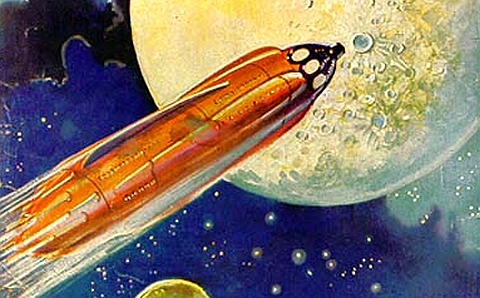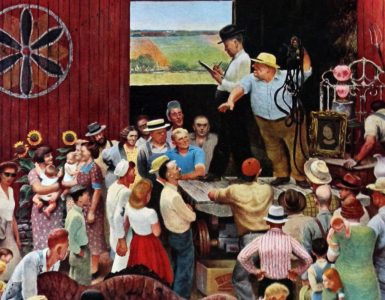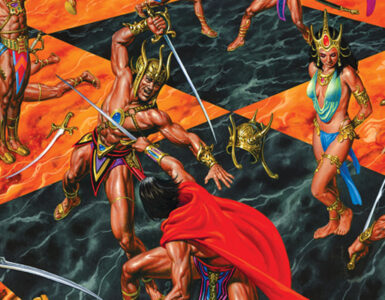AMAZING STORIES Under Thomas O’Conor Sloane
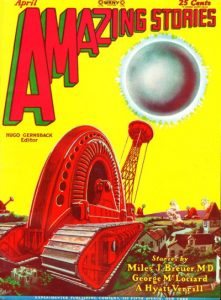 The last issue of AMAZING STORIES under Hugo Gernback’s editorship was dated April 1929. Following the bankruptcy of his publishing company, Gernsback was ousted from control. The receiver eventually refloated the company and it was sold to a new publisher, Mackinnon-Fly (later renamed Teck).
The last issue of AMAZING STORIES under Hugo Gernback’s editorship was dated April 1929. Following the bankruptcy of his publishing company, Gernsback was ousted from control. The receiver eventually refloated the company and it was sold to a new publisher, Mackinnon-Fly (later renamed Teck).
Gernsback, never one to rest on his laurels, formed a new company and launched a stream of science-fiction and technical magazines. The first, SCIENCE WONDER STORIES (which started with its June 1929 issue), was modeled closely on AMAZING STORIES and even contained stories that had been sent to Gernsback for AMAZING. In the next six months came AIR WONDER STORIES, SCIENCE WONDER QUARTERLY, and SCIENTIFIC DETECTIVE MONTHLY, plus a series of sf booklets.
It was at this time that Gernsback began using the term “science fiction.” His old term, “scientifiction,” had been registered as a trademark by his former company, and he was advised that he could not use it to promote his new publications. His new phrase (which, unknown to him, had been coined eighty years earlier by a long-forgotten Englishman, William Wilson) rapidly came into common usage.
This flurry of activity attracted the attention of other pulp publishers. William Clayton set his editor, Harry Bates, the task of preparing a new magazine, which appeared in December 1929 (cover date January 1930), entitled ASTOUNDING STORIES OF SUPER-SCIENCE. Bates was aware of the science fiction in AMAZING STORIES, though he wasn’t enamored of it. “What awful stuff, I’d found it!” he later wrote. “Cluttered with trivia! Packed with puerilities. Written by unimaginables.”
In thinking about the possibilities of science fiction Bates, alas, latched onto the lowest common denominator — the superscience extravaganza — and because Clayton’s company was a popular market for pulp writers (as distinct from Gernsback’s visionaries), the new writers of sf concentrated on the adventure angle to the detriment of sound scientific speculation. It was the Clayton ASTOUNDING, more than any Gernsback magazine, that lowered the quality of science fiction and stereotyped it as man-vs.monster/rescues-damsel stuff — a stigma with which it was long thereafter associated (and with which, thanks to series such as DOCTOR WHO, it is still associated by some today).
Before 1930 was many months old, it was clear that a division was emerging in science fiction. SCIENCE WONDER STORIES (soon to become simply WONDER STORIES) on the one side strove to publish the more purist form of technological science fiction. ASTOUNDING STORIES, on the other side, cared little for the accuracy of its science, provided it was the basis for an exciting adventure. In neither case were the stories of a high literary standard, and consequently science fiction’s image was suffering on both fronts.
So where did this leave AMAZING STORIES? When Gernsback left, the magazine and its companion QUARTERLY remained in the editorial hands of Thomas O’Conor Sloane, his former assistant.
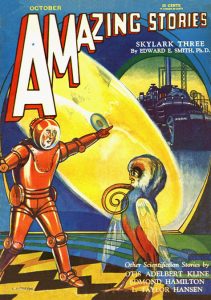 Sloane was not like Gernsback. For a start, he was seventy-seven years old (Gernsback was forty-four at the time), and while he was well grounded in Victorian science, he was not a visionary. He had been employed by Gernsback to run the administrative side of the magazine, specializing in proofreading and spotting scientific errors. He was a benign, amiable old graybeard who tolerated science fiction as an amusing diversion, but had no belief in what he published. He expected that no human would climb Everest, let alone travel into space. His editorials were stodgy essays on such exciting subjects as the light bulb. As a consequence, the stimulus and inspiration provided by Gernsback vanished from the magazine.
Sloane was not like Gernsback. For a start, he was seventy-seven years old (Gernsback was forty-four at the time), and while he was well grounded in Victorian science, he was not a visionary. He had been employed by Gernsback to run the administrative side of the magazine, specializing in proofreading and spotting scientific errors. He was a benign, amiable old graybeard who tolerated science fiction as an amusing diversion, but had no belief in what he published. He expected that no human would climb Everest, let alone travel into space. His editorials were stodgy essays on such exciting subjects as the light bulb. As a consequence, the stimulus and inspiration provided by Gernsback vanished from the magazine.
Nevertheless, science fiction fans — who were emerging in the hundreds, and were to organize themselves — are nothing if not loyal, and they welcomed this diversification in their favorite reading matter. They continued to support AMAZING STORIES, and for a time the magazine continued to publish stories that were close to the Gernsbackian mold.
AMAZING became as much a market for space opera as the other magazines, and it was in AMAZING that this branch of the genre reached its “cultural” peak. During 1930, the magazine not only published “Skylark Three,” E. E. Smith’s sequel to “The Skylark of Space,” but also Edmond Hamilton’s “The Universe Wreckers” and the series by John W. Campbell, Jr., about superscientists Arcot, Wade, and Morey. These were better than any equivalents in WONDER STORIES or ASTOUNDING.
Having scaled that peak, AMAZING was prepared to consider less cosmic alternatives. Hamilton, one of the earliest perpetrators of space opera, used AMAZING as the market for a change of pace in “The Man Who Saw the Future” (October 1930), which developed one of Gernsback’s throwaway ideas to consider how a man from the past would see the modern day. Likewise, Campbell, who had been a Sloane discovery, revealed he also had a subtler side, and though this would emerge more potently in ASTOUNDING STORIES in 1934 in stories such as “Twilight” and “Night,” it had its origins in AMAZING in “The Last Evolution” (August 1932), in which robots supersede humankind as masters of the earth.
In addition, Sloane relied on other Gernsback originals, including David H. Keller and Miles J. Breuer. Keller’s stories, such as ‘The Metal Doom” (May through July 1932), “No More Tomorrows” (December 1932), and “Unto Us a Child Is Born” (July 1933) are thoughtful speculations on the effects of scientific development (or lack of it) on society and the individual. Breuer continued to write his stories about the fourth dimension, including “The Book of Worlds” (July 1929) and “The Gostak and the Doshes” (March 1930), while with Clare Winger Harris, one of the few female sf writers of the day, he wrote “A Baby on Neptune” (December 1929), a clever story about space-time differentials.
Sloane sustained a few regular writers. Most of those who are closely associated with his magazine are, by and large, forgotten today except for the singularity of their names, such as Isaac R. Nathanson, Abner J. Gelula, Henry J. Kostkos, J. Lewis Burtt, Charles Cloukey, and Joe W. Skidmore. The one significant exception, apart from Campbell, was Neil R. Jones.
 Jones was good with ideas, but struggled to convert them into stories. He was not much of a writer, but he was a good storyteller, and he struck gold with his series about Professor Jameson. The professor had constructed a spaceship in his old age and planned to launch his body into space, where it would remain perfectly preserved. Forty million years later; long after life on Earth had passed away, the space coffin is found by a benevolent race of space explorers, the Zoromes. They are also superscientists, and have found a way of preserving their brains in robot bodies. They revive Jameson and transfer his brain to a robot. Thereafter he joins them on their exploration of the universe.
Jones was good with ideas, but struggled to convert them into stories. He was not much of a writer, but he was a good storyteller, and he struck gold with his series about Professor Jameson. The professor had constructed a spaceship in his old age and planned to launch his body into space, where it would remain perfectly preserved. Forty million years later; long after life on Earth had passed away, the space coffin is found by a benevolent race of space explorers, the Zoromes. They are also superscientists, and have found a way of preserving their brains in robot bodies. They revive Jameson and transfer his brain to a robot. Thereafter he joins them on their exploration of the universe.
The series began with “The Jameson Satellite” (July 1931), and eleven more stories in the same vein followed in AMAZING, concluding with “The Music Monsters” (April 1938). Jones wrote thirty Jameson stories in all, including a number in the late sixties that remain unpublished.
There was a belief at the time, as AMAZING‘s circulation began to fall, that it was the Jameson stories that were keeping the magazine alive. One little-known fact about the series is that the first story had originally been submitted to Gernsback at SCIENCE WONDER STORIES. In that version, the story consisted of a lot of boring detail about how Jameson planned and built his space coffin. Jones boldly ended the story by revealing that the sequel would be entitled “After 40,000,000 Years.” In rejecting the story, Gernsback gave the sound advice that it should be edited to form the preface to the sequel. This Jones did, but, due to his dissatisfaction with the slowness and amount of Gernsback’s payments, he submitted the revised story to AMAZING. Had Gernsback’s payment practices been better, he would have had the classic Jameson series, and one can only speculate what effect that turn of events might have had on AMAZING‘s circulation.
By 1932, America was in the grips of the Depression. The economic crisis was having an effect on many publishers, even though the public would still scrape together its dimes to purchase its favorite magazines. At this time, perhaps there was no better escape than into the worlds of science fiction. Nevertheless, the publishers of AMAZING STORIES could not ignore or avoid the effects of the Depression. The companion QUARTERLY slipped to semiannual publication in 1932 and ceased altogether in 1934. AMAZING, which had so far retained its large pulp format, shifted to the standard pulp size with the October 1933 issue to minimize production costs, though it then became lost among other bookstore pulps.
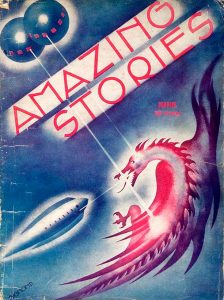 By now the magazine’s circulation had dipped to around 25,000, and it was doing little to attract new readers. Its covers were, for the most part, subdued. The mainstay artist was Leo Morey, Frank R. Paul having followed Gernsback to his WONDER stable, and though Morey’s covers were arguably better executed, they were drab and uninspiring compared to Paul’s. AMAZING did try one bold experiment during 1933, with a series of surreal symbolic covers rendered by an artist called A. Sigmond. Today these covers may be seen as revolutionary, but they met a cold reception from the readers of the 1930s, and probably harmed AMAZING‘s circulation.
By now the magazine’s circulation had dipped to around 25,000, and it was doing little to attract new readers. Its covers were, for the most part, subdued. The mainstay artist was Leo Morey, Frank R. Paul having followed Gernsback to his WONDER stable, and though Morey’s covers were arguably better executed, they were drab and uninspiring compared to Paul’s. AMAZING did try one bold experiment during 1933, with a series of surreal symbolic covers rendered by an artist called A. Sigmond. Today these covers may be seen as revolutionary, but they met a cold reception from the readers of the 1930s, and probably harmed AMAZING‘s circulation.
Sloane did little to enliven the magazine internally. He had passed his eightieth birthday in November 1931 and, despite a surprisingly agile mind, he seemed to exist in a timeless cocoon, oblivious of what else was happening in the science fiction world. He frequently held onto manuscripts for several years before publishing them, so that the general tone of his magazine was out of sync with developments elsewhere. During 1932 and 1933, Gernsback, through his editor David Lasser, was pumping new respectability into science fiction, encouraging writers to include more realism in their stories. Many writers took up this challenge, initially Nathan (Nat) Schachner, Laurence Manning, P. Schuyler Miller, and Edmond Hamilton, but few of these were selling regularly to AMAZING, and when they did their stories often failed to appear for some years. Sloane was becoming increasingly remiss at notifying authors that stories had been accepted. This practice caused him one particular embarrassment when he published Malcolm Afford’s “The Ho-Ming Gland” in the February 1933 AMAZING — unaware that the story had already appeared in the January 1931 issue of WONDER STORIES. Afford, not knowing Sloane had accepted the story, and possibly thinking the manuscript had been lost, had tired of waiting to hear from Sloane and had submitted the story to Gernsback, who published it promptly.
By 1934 ASTOUNDING STORIES was eclipsing WONDER as the leading science-fiction magazine. William Clayton’s company had gone bust in 1933, due as much to his delight in gambling as to the Depression, and ASTOUNDING had been purchased by the venerable firm of Street & Smith. That company’s editor, F. Orlin Tremaine (who had some time before worked for Clayton, though not at ASTOUNDING), radically improved the magazine. Many writers, including Nat Schachner, Donald Wandrei, Jack Williamson, John Russell Fearn, Murray Leinster, Thomas Calvert McClary, C. L. Moore, and E. E. Smith, plus John W. Campbell, Jr. (writing as Don A. Stuart), noted the restraint shown by the new Gernsbackian sf, and fired it with the sense of wonder of the original scientific romances to produce a new strain of cosmic realism. Science fiction was born anew in the pages of ASTOUNDING during 1934 and 1935.
Those who solely read AMAZING would have been ignorant of this phenomenon. Writers submitted their stories to ASTOUNDING first, because it paid promptly and was the place to be, and to WONDER STORIES second, for, although Gernsback paid poorly, WONDER remained a fun magazine, supported by a vocal fan community in the newly established Science Fiction League. AMAZING was the last resort, and had become the backwater of science fiction.
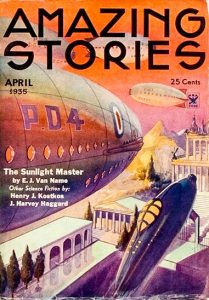 On the whole, AMAZING was boring. In order to save money, Sloane was reprinting ancient stories by Jules Verne, Fitz-James O’Brien, Edgar Allan Poe, and Edward Everett Hale. O’Brien’s “The Diamond Lens” appeared in the October 1933 issue — less then seven years after it had been printed during the Gernsback era, in December 1926. Reprints of Poe stories were used in four of six consecutive issues beginning in November 1933. In the middle four months of 1934, Sloane spent considerable space serializing Verne’s “Measuring a Meridian.” Few of these rehashed stories were science fiction even by Gernsback’s original standards: Poe’s “The Gold Bug” (April 1934), for instance, being a story of cryptography.
On the whole, AMAZING was boring. In order to save money, Sloane was reprinting ancient stories by Jules Verne, Fitz-James O’Brien, Edgar Allan Poe, and Edward Everett Hale. O’Brien’s “The Diamond Lens” appeared in the October 1933 issue — less then seven years after it had been printed during the Gernsback era, in December 1926. Reprints of Poe stories were used in four of six consecutive issues beginning in November 1933. In the middle four months of 1934, Sloane spent considerable space serializing Verne’s “Measuring a Meridian.” Few of these rehashed stories were science fiction even by Gernsback’s original standards: Poe’s “The Gold Bug” (April 1934), for instance, being a story of cryptography.
Worse still, Sloane published some new stories that were the real nadir of science fiction. Take “The Romance of Posi and Nega” (September 1932), the first of a series by Joe W. Skidmore that treated electrons as sentient beings. Or, what could arguably be called the worst story ever published in an American sf magazine, “The Universal Merry-Go-Round” by Roger Bird (April 1933). This story is so bad as to be compulsive reading, and no plot summary can do it justice. For starters, consider that it involves two men intent on a trip into space but who believe confinement in their capsule will drive them mad. They propose to take along the professor’s daughter — not for company, or anything else you might imagine, but to play the violin!
Merely by the law of averages, Sloane should have published some good stories, but his quota of decent material was woefully small, and probably arrived more through luck than through design. These included several stories by S. P. Meek, such as his adventures in a lost South American city, “The Drums of Tapajos” (November 1930 through January 1931) and “Troyana” (February through April 1932), plus his Ray Cummings-like stories in a subatomic world, “Submicroscopic” (August 1931) and “Awlo of Ulm” (September 1931). Meek’s stories weren’t particularly well written but were nonetheless lively and fascinating.
From Charles R. Tanner came “Tumithak of the Corridors” (January 1932) and “Tumithak in Shawm” (June 1933), about mankind’s subterranean resistance movement against the Venusian sheIks who now dominated the Earth.
“The Lost Machine” (April 1932) was a poignant robot story by John Beynon Harris (better known in later years as John Wyndham).
Howard Fast, a name more readily associated with the novels FREEDOM ROAD and SPARTACUS, made his first story sale to AMAZING with ‘Wrath of the Purple” (October 1932), about a virulent cellular lifeform that destroys all other living things.
“Omega, the Man” (January 1933) by Lowell Howard Morrow was a moving story of the last humans alive on Earth. Sloane had held onto this story for at least two years before publishing it, and had it appeared in 1930 it would have been heralded as a major breakthrough in realism.
Sloane could have made up for this omission had he accepted Edmond Hamilton’s “Colonists of Mars” in 1934, but he rejected it as being “well written, but too horrible.” The story lay in a back drawer for twenty years before Hamilton resurrected it and revised it under the title ‘What’s It Like Out There?” It appeared in THRILLING WONDER STORIES in 1952, at which time it was heralded as a bold new treatment of the realism of space colonization.
Harl Vincent established himself in the early AMAZING but went on to become an ASTOUNDING regular. His “Parasite” (July 1935) is an overlooked classic about an invisible alien intelligence that takes control of humans.
Finally, there was “He Who Shrank” (August 1936) by Henry Hasse, a noted classic about smallness that was the author’s first solo appearance in a professional magazine.
These are most of the few stories of merit or interest that AMAZING published in the early to mid-1930s. To his credit Sloane did manage to nurture a few writers who would later develop significant reputations. He published several stories by Eando Binder, the name used by the writing team of Earl and Otto Binder. Earl later moved away from writing but Otto continued to sell stories under the original name and others. Sloane bought their first story, “The First Martian” (October 1932).
John Russell Fearn made his debut with “The Intelligence Gigantic,” a serial in the June and July 1933 issues which set the tone for his cosmic career. Fearn became a regular contributor to AMAZING, often under pen names, and became one of the most prolific writers of science fiction in the 1940s and 1950s.
Finally, although he could not have known at the time what a service he was performing, Sloane used a poem entitled “Elegy to a Dead Satellite: Luna” in the October 1937 issue. This was the first appearance in print of Elton V. Andrews, a pseudonym used by a young man who would later be known to one and all by his real name: Frederik Pohl.
But these discoveries were hardly enough, at the time they occurred, to measurably alter AMAZING‘s course. The magazine, which had been a monthly publication from the start, went bimonthly after the August 1935 issue, and there the real downward spiral began. Readers faded away until, by 1937, the circulation was only about 15,000. Its publishers sold the magazine to William B. Ziff, a former World War I pilot, who had established the Ziff-Davis Publishing Company in Chicago in 1935 with Bernard G. Davis. The company initially published magazines aimed at rich hobbyists, such as POPULAR PHOTOGRAPHY and POPULAR AVIATION, but Davis wanted to expand into the pulp fiction field. AMAZING was an opportune choice. The deal was made in January 1938, with the June 1938 issue the first one that was fully under Ziff-Davis’s control.
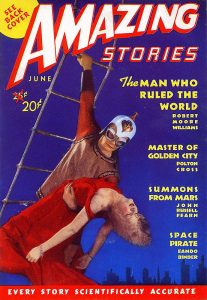 Bernard Davis was in overall editorial control of the magazine, but as managing editor he appointed Raymond A. Palmer, one of the most active fans in the sf field, to whom he entrusted the task of procuring material. Palmer was twenty-seven years old, sixty years Sloane’s junior. A change in style was inevitable, but it was even more dramatic than the age gap would suggest. Palmer threw out the old Teck material and established a new policy for lively, adventurous stories aimed at a young market.
Bernard Davis was in overall editorial control of the magazine, but as managing editor he appointed Raymond A. Palmer, one of the most active fans in the sf field, to whom he entrusted the task of procuring material. Palmer was twenty-seven years old, sixty years Sloane’s junior. A change in style was inevitable, but it was even more dramatic than the age gap would suggest. Palmer threw out the old Teck material and established a new policy for lively, adventurous stories aimed at a young market.
Hugo Gernsback must have winced at what was happening to his brainchild. Two years earlier, Gernsback had given up WONDER STORIES, his poor financial management once again having endangered one of his publications. WONDER STORIES had been bought by Standard Magazines and converted into THRILLING WONDER STORIES, which also aimed at the younger reader. Now AMAZING was pitching for an even younger readership, basically the young teenager. The magazine was given a facelift with striking front and back covers by local Chicago artists Robert Fuqua, Howard McCauley, and Julian S. Krupa. All of these illustrators had an eye for action, and the magazine was instantly attractive.
The interior artwork was also beefed up, and stories were given more sensationalistic titles. Palmer almost habitually changed authors’ titles, not always for the better, but his methods gave the magazine a consistency that was easily recognizable and with which many of its readers could associate.
However, the older generation of readers was horrified. A few remained loyal, but most shifted their allegiance to ASTOUNDING where, since December 1937, John W. Campbell, Jr., had been the editor and was leading science fiction into its Golden Age.
Palmer, being based in Chicago, was able to call upon a new stable of writers to build his own brand of science fiction entertainment. He scored several early successes.
Robert Bloch had always been a fan of science fiction, but heretofore had concentrated on weird and mystery fiction. Palmer bought Bloch’s first science-fiction story, “Secret of the Observatory” (August 1938), and published his powerful psychological sf story, “The Strange Flight of Richard Clayton” (March 1939).
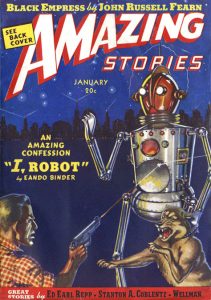 Palmer also published Eando Binder’s “I, Robot” (January 1939), a touching story about a selflessly noble machine. This story made an impression on the young Isaac Asimov, and it was in AMAZING that Asimov first appeared professionally in print, with “Marooned Off Vesta” (March 1939).
Palmer also published Eando Binder’s “I, Robot” (January 1939), a touching story about a selflessly noble machine. This story made an impression on the young Isaac Asimov, and it was in AMAZING that Asimov first appeared professionally in print, with “Marooned Off Vesta” (March 1939).
Palmer also acquired William F. Temple’s “The Four-Sided Triangle” (November 1939), an ingenious story about two men in love with the same woman and how the situation is complicated with a matter-duplicator.
Nelson S. Bond, a more talented writer than he is usually judged to be, appeared with a superior consideration of a future feudal society in “The Priestess Who Rebelled” (October 1939).
By the end of the 1930s, AMAZING STORIES was firmly reestablished. It was back on a monthly schedule — which was reinstated after the October 1938 issue — and it had a new companion magazine, FANTASTIC ADVENTURES (first issue dated May 1939). In a little more than a year Palmer had turned the magazine’s fortunes around, but at the risk of alienating the more serious members of the sf community.
But Palmer was undeterred. He was rapidly building AMAZING‘s new reputation. Even if history records that it was ASTOUNDING that led the science-fiction revolution and published more sf classics than the other magazines put together, in terms of sales it was Palmer who won the race. The magazine’s circulation soon exceeded ASTOUNDING‘s and continued to rise. AMAZING was ready to face all odds, and as war clouds gathered, Palmer prepared the magazine for its third decade.
“The AMAZING Story: The Thirties — Escape from Oblivion” is © 2016 by Mike Ashley and appears here with the author’s permission. Notes in italics are by PulpFest and are © 2016 by PulpFest. The original article was published by TSR, Inc. and edited by Kim Mohan for the February 1992 issue of AMAZING STORIES. Many thanks to Curt Phillips, the moderator of the Yahoo newsgroup PulpMags, for drawing our attention to and providing us with copies of Mike Ashley’s exceptional series of articles about the world’s first science-fiction magazine. Please visit pulpcon.org on Thursday, February 25th, for the third segment of the series.
(Concerning our illustrations . . . . The April 1929 issue of AMAZING STORIES — featuring front cover art by the publisher’s favorite illustrator, Frank R. Paul — was the last issue of the magazine to be published by Hugo Gernsback. Leaving with the publisher was his preferred artist. Only two more Paul front covers would adorn AMAZING STORIES until the early sixties — the May and June issues of 1929. The Austrian-born artist would quickly resurface, painting the covers for Gernsback’s new magazine, SCIENCE WONDER STORIES, and its companions.
Following Paul’s departure, AMAZING was without a regular cover for the first time in its history. For his early issues at the helm of the magazine, the pulp’s new editor, T. O’Conor Sloane, would turn to Hans Wessolowski — who signed his paintings as “Wesso” — and Leo Morey. The latter — a native of Peru — would become the magazine’s regular cover artist beginning with the January 1930 number, a role he would largely retain until AMAZING again changed hands with its acquisition by Ziff-Davis in 1938. Three of his works are pictured above: the October 1930, August 1932, and April 1935 issues of AMAZING STORIES.
At the beginning of 1933, Morey’s front cover paintings were temporarily replaced by a series of what have been called surreal or abstract covers, credited to an artist who signed the works “A. Sigmond.” Pictured here is the February 1933 cover featuring spaceships battling a dragon. According to Everett and Richard Bleiler’s SCIENCE FICTION: THE GERNSBACK YEARS (1998): “His/Her work, which included the lettering, is modern, competent, and attractive, although without display value or sales appeal . . . It seems obvious that Sigmond’s covers were associated with a desire to reduce printing costs, for one used only a blue plate, others only blue and red; only one cover applied full three-color printing . . . While artistically correct and aesthetically pleasing, Sigmond’s covers were undoubtedly disastrous on the newsstands.”
Nothing is known about A. Sigmond. However, according to Mort Weisinger’s column “The Ether Vibrates” in the July 1933 issue of SCIENCE FICTION DIGEST, “The July (1933) cover of the same mag (AMAZING STORIES, signed as by Sigmond), was a composite of the work of three or four different artists, Morey tells me.” Sigmond is credited with the January through July 1933 covers for AMAZING STORIES. Afterward, Leo Morey would return to painting the magazine’s covers. He would continue to do so through the April 1938 issue.
By 1937, AMAZING’s circulation had dropped to approximately 15,000. Its owners sold the magazine to Ziff-Davis, a publisher of hobby magazines that desired to enter the pulp industry. Ray Palmer, a very active science fiction fan, was named AMAZING’s managing editor. His first issue at the helm was the June 1938 number. It featured a “bold new title design” and a photographic cover created by Horace Hime, his one and only cover for AMAZING STORIES.
Beginning with the October 1938 issue, Palmer’s favored cover artist was Joseph Wirt Tillotson, who signed his work “Robert Fuqua.” The artist would contribute all but the June 1939 cover over the next year. In addition to AMAZING, Fuqua also contributed cover and interior illustrations to Ziff-Davis’s AIR ADVENTURES, FANTASTIC ADVENTURES, MAMMOTH ADVENTURE, MAMMOTH DETECTIVE, MAMMOTH WESTERN, and SOUTH SEA STORIES. From 1938 to 1951, he painted eighty front and back covers for AMAZING STORIES.)

